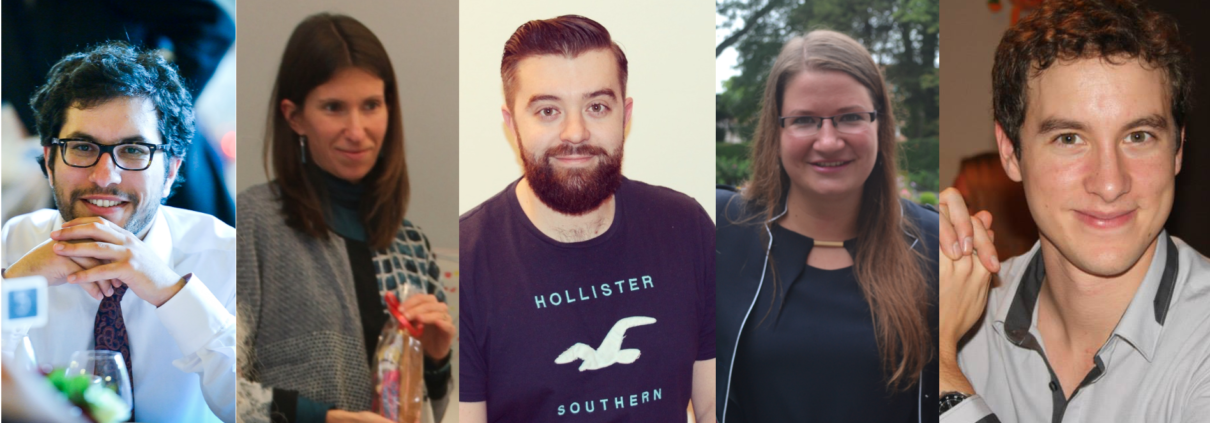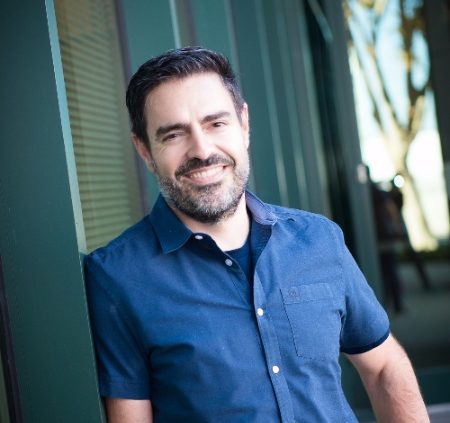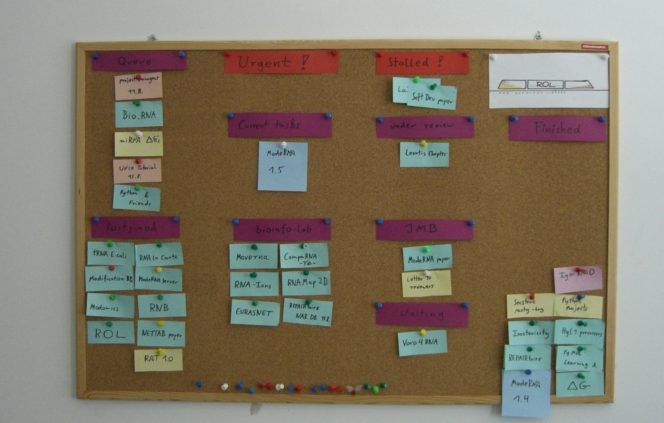What possibilites can Agile offer in an academic setting? This is explored by a five-member teacher’s team at Brussels Engineering School, ECAM. Crastina had a chat with Benjamin Berger, Assistant Professor.

Introducing a modified Agile method for the students seemed like a step into the unknown for the teachers at ECAM. At the outset, the team members actually did not have a perfectly clear view of what Agile was. Some of them had a brief explanation in a management class some years ago, or during some presentation, but nothing more than that.
”To be honest, we did not really think it could be translated in an academic frame,” Benjamin says.
Exploring Agile
Benjamin Berger and his colleagues should, however, be convinced very soon that Agile could be useful for the students of ECAM. It started with a friend of Benjamin sharing a post on LinkedIn, talking about improving the way students worked in project from two researchers – who happened to be Laura and Marina of the forthcoming team. They were at the time exploring possibilities of Agile in academic world.
”We had been trying for years to improve the way students work on projects, trying to reduce their procrastination to avoid the end-of-semester rush,” says Benjamin. “I contacted Laura and Marina, and they convinced me very quickly to give it a try because it could address some problems we met.”
The current project is for 1st-year engineering students. Because of the large number or students (more or less 400), it seemed important for the team to implement the Agile Method.
“The subject is renewed every year but the goal is always the same: build a working prototype of a machine in link with the year’s theme,” Benjamin says.
Practical projects
The said theme can for example be an automatic dispenser, an aquaponic system, a ball launcher, an automated insect farm, or something similar. The goal is to use and develop hard skills like electronics, electricity, or mechanics on a practical project while working in teams.
“This will force them to learn collaboration, project management, and other soft skills that are sometimes forgotten in an academic context,” Benjamin says.
As there are a lot of students group to manage, the group received help from 4th-year students that are following a management class and have to apply what they learn in managing the students teams.
“We adopted an Agile-like method to fit our semesters and had to define the role of 1st-year students and the roles inside the groups, 4th-year students, and the role of teachers regarding the Agile method,” Benjamin says. “ We received some necessary help from Laura (big thanks to her!) in order to get what was essential in Agile methods and how to translate it into our project.”
How was the feedback from the students?
“I think the students did not really realize it was a new management method as they had never experienced one before. As it is the first project for them, it is difficult for them to evaluate the benefits of the method. For the 4th-year students who knew the project “without the Agile method”, we can say that they played the game by distributing the roles of Scrum Master etc. within their teams throughout the semester.”
What is your experience so far?
“I think students adopted the method quite easily and we could really see the improvements in the first two rushes we made with them before COVID19 put everything on hold. The work was better distributed during the first weeks of the projects and they had results faster than the years before. For example, the first rush closed on a cardboard prototype, helping them realize the dimensions of their prototype better than with a 3D view, making them see that assembly could cause some problems, etc.”
What are your plans – will you develop this further?
“We really can’t wait to try it again in January 2021, hoping this time there won’t be external elements influencing the project! Some of us will also try this method in other classes and projects.”
Three pieces of adviceBenjamin gives three pieces of advice to the teacher or scientist who wants to try a similar setup. • Do not hesitate to discuss with your colleagues and ask for help. The academic and scientific community likes to share their knowledge and it could really make you save time! • Find and adapt the method to your style so that it fits your needs, even if it is not purely Agile. 😉 • Try to document and evaluate the impact of the new management method you are putting in place; it is really important to measure the improvements. If I could just add one more thing, it is something one teacher once said to me: “Do not hesitate to try new learning methods. Even if the students do not learn anything new, you will!” |
On 4-5 October, a unique course in Agile Project Management will take place at Karolinska Institutet, the medical university in Stockholm. The initiative comes from Peter Solsjö – biomedicine nerd, communicator, and Agile enthusiast.
 “In this weekend workshop, students and doctoral students will be introduced to agile and scrum ideas,” Peter Solsjö says. “It will take place at the student union at Karolinska Institutet in Stockholm, and can be seen as a kind of satellite event of the yearly CHaSE career fair. Using an experimental approach, we will investigate if KI is ready for agile science!”
“In this weekend workshop, students and doctoral students will be introduced to agile and scrum ideas,” Peter Solsjö says. “It will take place at the student union at Karolinska Institutet in Stockholm, and can be seen as a kind of satellite event of the yearly CHaSE career fair. Using an experimental approach, we will investigate if KI is ready for agile science!”
Peter Solsjö describes himself as a biomedicine nerd with “a background in a bit of this and that” – ranging from medical research on the thyroid, to advocacy and PR-work in the life science sector in Sweden.
– I have a passion for medicine and technology and in my spare time, I read and explore the world.
 Working as a quality assurance officer at Astra Zeneca in Stockholm, Peter Solsjö came in contact with agile as a working method. “I was struck by the manner through which structure was created easily in a complex organization,” he says. “This provided room for thought-through improvements in different areas and clearer communication among many stakeholders. Agile is a great working philosophy for staying nimble yet structured in a chaotic high-tech world.”
Working as a quality assurance officer at Astra Zeneca in Stockholm, Peter Solsjö came in contact with agile as a working method. “I was struck by the manner through which structure was created easily in a complex organization,” he says. “This provided room for thought-through improvements in different areas and clearer communication among many stakeholders. Agile is a great working philosophy for staying nimble yet structured in a chaotic high-tech world.”
Personally, Peter Solsjö would define the concept of “agile science” as a framework used to create the most value in research out of the least amount of effort – this by re-considering traditional project management. “Agile as a philosophy goes hand in hand with research since it adopts the scientific method and adheres to empiricism as the cornerstone in critical decisions,” he says. “However, to structure research and reach scientific insights quicker agile tools may provide structure to the lab workflow, that might sometimes be missing, or help expand the hypothesis horizon.”
So what pieces of advice would you give to the science person who is curious about agile stuff?
- Read the Agile Manifesto and consider what it means for your workday or spare time project.
- Learn one agile tool really well. I recommend starting with Scrum or Kanban.
- Test your new skills in your everyday life. Try, fail and repeat until you succeed!
For more information, please contact Peter Solsjö at email address.
As described earlier here in this blog series, science has been very slow to respond to Lean and Agile. However, the earliest signs of a science person doing an intellectual exploration of Agile goes back almost ten years.
When I first started to google for the concept ”Agile Science”, I quickly found stuff signed Xavier Amatriain, a Catalan computer scientist (although he chose to call it Agile Research). For example, in a presentation on SlideShare from 2008, he describes how Agile methods are used in the software industry, and then speculates how it could be used in a scientific process (see slide below).
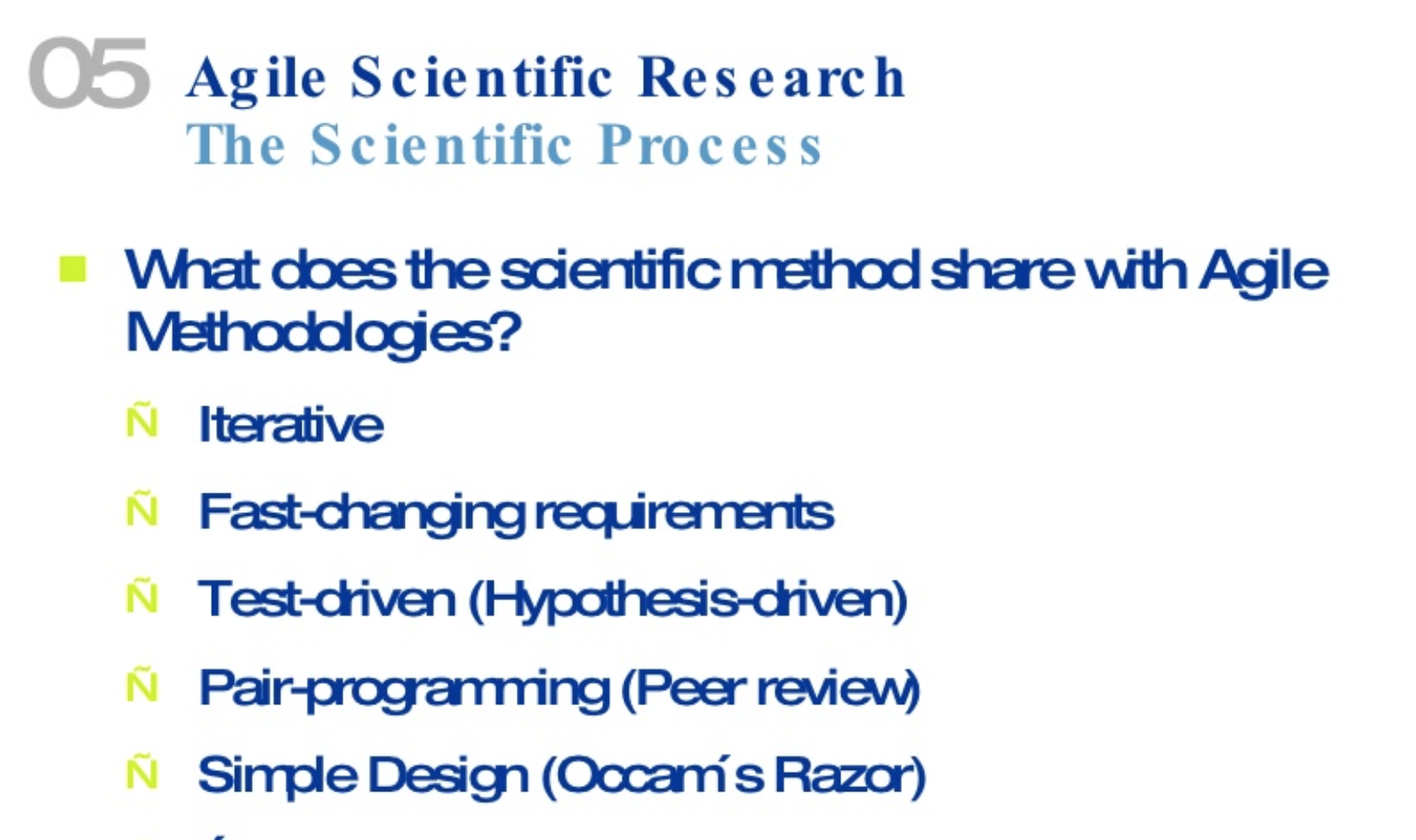 .
.
He even wrote a draft for an Agile Research Manifesto in 2009!

I got in touch with Xavier by email.
Hi, Xavier! Tell me a little about your background and how you came to be interested in Agile.
I have been in research and research management for quite some time. Even as I was doing my Ph.D. back in the year 2000, I was already managing teams of researchers and open source developers around the world. After my Ph.D., I went on to manage research teams both in academia and industry. I eventually went completely into the industry, but I have always managed teams with a very strong research component.
What was the response when you wrote about the concept Agile Research in 2008–2009?
To be honest, I did not invest at all in promoting the manifesto beyond some blog posts. What I was writing seemed mostly “common sense” and I was more interested in sharing my research projects. So, while I did get some response, especially through a LinkedIn group I created to discuss Agile Research, it was not very impactful.
What was the outcome of your early initiatives, e.g. the Manifesto?
As I mentioned, I did not seek nor get much public impact, so the outcome was mostly in my most immediate circles and projects I managed.
How are you using Agile today in your current work position?
Agile is now part of everyday technical work in all innovative tech companies. I now work in a small startup in the Silicon Valley after having managed teams at companies such as Netflix and Quora. The interesting thing now in the Valley is that most innovative “agile” companies rarely talk about Agile anymore.
On the one hand, it is assumed that you need agility to succeed, and practices like Scrum or the like have a bit of a bad name because of the way they have been implemented in larger corporations. However, all startups try to be lean and agile. As a matter of fact, if you read about the popular “Lean Startup” approach you realize that most of it is borrowed from agile methods, and it has a lot of similarities with my original thoughts around Agile Research.
In general – how to do think science can benefit from Agile?
Science, in general, should aim to be Agile. There is a lot of value in scientific research in designing smaller experiments, having continuous feedback, and iterating while adapting requirements to the new data. Even in longer, larger projects, it is beneficial to find the way to break them into smaller increments. Science, even more so than software development, is a learning process. You cannot expect to have the complete specification of what you are going after from the beginning.
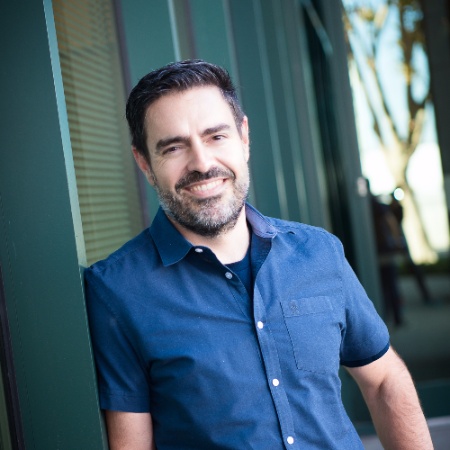 Which special modifications have to be done when using Agile in a scientific setting?
Which special modifications have to be done when using Agile in a scientific setting?
Probably the biggest difference in a scientific setting is that there is no clear “client” with whom you can discuss the results of each iteration. Because of that, it is important to find who can take on that role. In my experience, this generally has to be the mentor or manager. However, that does introduce a set of requirements on how that person/people are able to provide meaningful and continuous feedback.
 While being a postdoc in bioinformatics, Kristian Rother came to embrace Lean & Agile thinking. Accordingly, he started to use Kanban to juggle all the projecs he was running. “Agile is not a book of rules, you still have to do a lot of thinking,” Kristian Rother says. “And yes, it fully applies to academic research.”
While being a postdoc in bioinformatics, Kristian Rother came to embrace Lean & Agile thinking. Accordingly, he started to use Kanban to juggle all the projecs he was running. “Agile is not a book of rules, you still have to do a lot of thinking,” Kristian Rother says. “And yes, it fully applies to academic research.”
While googling for the combination kanban + science I found a short but interesting article on how to use a Kanban board in science from a course in time management for scientists. The course was written by Kristian Rother, former scientist in the structural bioinformatics field. Today he is a freelancing science trainer, running his own company Academis, and still very passionate about the Agile mindset.
I got in touch with Kristian and asked some questions by email.
Hi Kristian, do you think that The Agile Manifesto can be useful for individuals and groups in academic research?
“Agile has given us the consciousness that there is an alternative to stiff, long-term plans and GANTT charts even in complex projects involving technology. Any researcher trying to write a 3-year plan, knowing that reality will be different, probably will see the usefulness of that. Next, Agile has produced a set of tools: Backlogs, Kanban boards, Burndown charts that help us to manage complex projects reasonably while keeping the ultimate goal in mind. Some of these tools are specific for software development (engineering practices like Continuous Integration), but much is very general. The manifesto itself is not so important. Agile is not a book of rules, you still have to do a lot of thinking. And yes, it fully applies to academic research.”
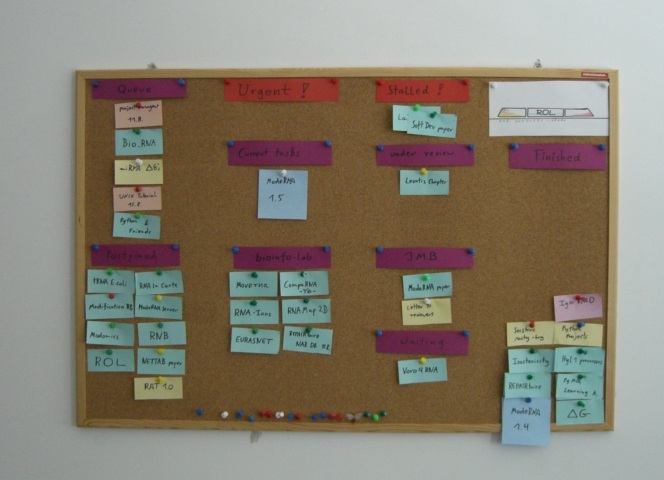
How were you introduced to Kanban yourself?
“I first read about Kanban while preparing for my Scrum Master certification. A key piece to understand what Kanban is about was the comic “One Day in Kanban Land” by Henrik Kniberg. Later, I read the original Kanban book by David J. Anderson. That one targets software developers in big companies and I think the book is too heavy for someone who just wants to try it. To get a first impression in a seminar or workshop, I can warmly recommend the “Kanban Pizza Game”.
As a postdoc, I had a constant influx of tasks from 20 different projects. One day I wanted to sort my 100+ tasks and prioritize. I asked my PI for a pinboard above my desk. For some reason, the university moved at lightspeed, and a few days later the laboratory had about 5 square meters of pin boards on the walls. I used mine as a Kanban board and experimented with a few extra features: A place to park tasks that were handled outside (e.g. papers for review) and an express lane for urgent tasks. But the most crucial thing was limiting work in progress (to three items). The system handled the pressure quite well, and we pushed quite a few papers out in the next two years.
Nowadays I switched to the online tool Trello, which is less rigorous. But I also have less urgent stuff to do.”
Have you used any other methods from the Lean & Agile toolbox?
“My recommendation if you want to try anything Agile is: Understand what a backlog is and build one for yourself. I have them all over the place (for multiple projects and stakeholders) and it is the main reason that things rarely get lost. The other tool I am using on a regular basis are Burndown Charts. I use them mainly for book translations (when the number of lines to translate is known precisely). When I write myself, I find Burndown Charts much less useful, because there is no clear definition what ‘done’ means. When working in a team, we do regular retrospectives. Whether it is possible to have a honest, constructive retrospective (or an equivalent) or not is in my experience a reliable predictor of whether a team will be successful or not.”
What is Agile Science? I still don’t know, but as a former molecular biologist who is writing about Agile issues for organisations like Softhouse and Scania, I certainly like the sound of the expression. Feel free to join me on my exploration!
In 1921, the Italian Nobel Prize winner Luigi Pirandello published his play Sei personaggi in cerca d’autore, Six Characters in Search of an Author. This title comes to mind when i start this exploration of the concept ”Agile Science”. It is namely a concept in search of three things:
- A definition.
- A model.
- A use.
So, in true Agile spirit, I hereby present the first iteration.
Definition, v. 0.9
Agile Science is the use of Agile principles, as described by the Agile Manifesto, to make faster scientific progress, increase the quality of scientific documentation and communication and improve the psychosocial environment in research labs and academic departments.
Model, v. 0.9
The initial model I propose is this:
- Scientific output is the product of a tight team, rather than a loose cluster of individuals.
- Scientific work is divided into three phases: (1) hypothesis creation, (2) data production and (3) data analysis.
- For phase (2), the following ways-of-working can be used to give a better throughput, improve cooperation and decrease stress: an iterative approach, Kanban and a modified version of Scrum.
Use, v. 0.9
I suggest that Agile Science is initially used to produce large amounts of data during repetitive runs of well-established methods.

I don’t know what this is yet, but it is my prototype and it is cool!



